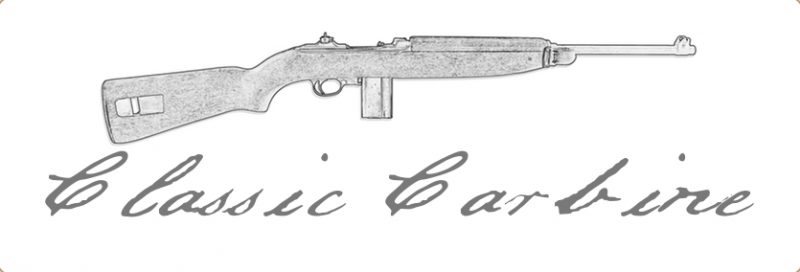Classic Carbine Qualification Test
Overview
This is our classic basic carbine skills test. It requires scoring hits in a variety of positions against targets at known distances. This event may be fired at 7 yards against scaled targets or 25 yards against full-size targets.
We use this skills test at selected Rifle 125 events (usually two-day versions), some Rifle 223 carbine events (again, on two day versions, often as an intermediate or “warm up” activity), and some Rifle 262 field events (usually as a tool to use the concept of “battlesight zero”).
This event is conducted in the NRA AR Challenge “Basic Match” format.
History
This skills test is based on the traditional WW2 M1 carbine qualification course of fire from FM 23-7 dated May 20, 1942 supplemented by the qualification scores from AR 775-10. It was originally fired on partial “A” and “B” type targets at 100, 200, and 300 yards.
We have simplified the scoring. The WW2 marksmanship standards emphasized accuracy over speed, so you will notice fire at longer ranges than is common today. This is a little different from some more modern skills evaluations, however, for a basic class it fits perfectly with our focus on sound marksmanship fundamentals. With a firm foundation making “Hits Count,” it is easy to add speed or additional skills at shorter ranges against larger targets.
Targets
Stage one is fired on a target equivalent to a 21″ diameter circle (or “D” style target). Stages 2 and 3 are fired against targets equivalent to a 31″ diameter circle (or “E” style target). When fired at other distances, appropriately scaled targets are used.
Practice targets are available to Sustaining Members at the Member’s Resources page.
Stages
| Stage | Distance | Position | Time | Rounds |
|---|---|---|---|---|
| 1 | 100 yds (“D”) | Standing/Kneeling | 0:35 | 4+4 |
| 2 | 200 yds (“E”) | Standing/Kneeling | 0:35 | 4+4 |
| 3 | 300 yds (“E”) | Prone | 0:20 | 2+2 |
On stages 1 and 2, the shooter starts standing and fires four rounds. They then transition to the kneeling position and conduct a speed reload before firing four more rounds. All transitions between positions are to be conducted from a bolt locked open on an empty chamber with safety on. Shooters will load only four rounds in the first magazine for the standing portion of the stage.
On stage 3, the shooter starts prone and fires two rounds. They then conduct a speed reload before firing two more rounds.
Special Procedures & Equipment Notes
- Shooters may not begin the stage “slung up.” A hasty sling may be used for support but the shooter must get into the sling on the clock. In a formal NRA AR challenge event shot for score, slings must cross the competitors back (i.e. no “parade ground” style slings); in a less formal training clinic a parade ground or classic USGI-style sling may be used.
- Bipods (if used) may not begin in the deployed position; they must be deployed on the clock. If used, the bipod must remain mounted through the entire course.
- Optics (if used) must begin with at the lowest power setting. Iron sights with multiple flip apertures begin with the large aperture in place. The sights may be adjusted once time begins.
- Spare magazines used for reloads must be carried on the shooter’s person.
- Generally there are no “classes.” At the Event Director’s discretion, or if being used for NRA AR Challenge competition purposes, scores may be split into three classes. Some shooters consider it a point of pride to qualify with “irons alone” or with a basic lower-powered service-style optic.
- Irons: Iron sights.
- Optics: Any single optic, with backup iron sights if desired.
- Open Optics: Any combination of multiple optics. A magnifier behind a red dot counts in the open optics class per the NRA AR Challenge guidebook.
Scoring
All firing is from the “ready” position.
Hits count for one point.
| Marksman | Sharpshooter | Expert | Master |
|---|---|---|---|
| 15/20 | 17/20 | 19/20 | 20/20 |
Shooters who score as “sharpshooters” or better receive a “classic carbine” certificate and patch. These score cutoffs are based on the WW2-era qualification standards.
Shooters consistently scoring as “sharpshooters” on this event are well prepared to try their hand at a wide variety of carbine events, to include CMP’s M1 Carbine matches or the NRA America’s RIfle Challenge.
Variants
- 25 Yards: In order to avoid moving the firing line and to allow use at ranges that only allow firing at reduced distances, we have a variant with scaled targets intended for use at 25 yards only.
- 200 yards: Some facilities only have 200 yards available. In this case, standard 21″ targets are used at ranges of 100, 130, and 200 yards.
- 100 yards: Some facilities only have 100 yards available. In this case, 10.5″ targets (our standard carbine targets) are used at ranges of 50, 65, and 100 yards.
- Reduced Round Count: We have a 10-round variant useful as a practice for our modern carbine challenge as well as a diagnostic event.
- Double Round Count: We use a 40-round variant which also exercises the seated position. Stages 1 and 2 are repeated, using the seated position on the second run. The round count on stage 3 is increased to 4+4.





You must be logged in to post a comment.